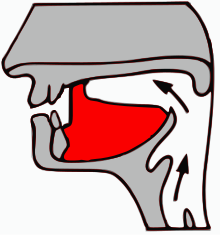Retroflex
A retroflex ( Latin retrō "back" and flectere "bend") is an apiko - postalveolar or sublamino-prepalatal speech sound , that is, when it is formed, the tip of the tongue or the tongue is placed behind the perineum. The tongue bends upward back . Another name for retroflex, which is commonly used in Indology, is cerebral (from the Latin cerebrum "brain, skull"). In the older literature, especially in Nordic linguistics, one also finds the term kakuminal or domal for this .
| IPA | description | example |
|---|---|---|
| ɖ | voiced retroflex plosive (retroflexes d) | swed. bord (table) [ buː ɖ ], Hindi डाल (branch) [ ɖ ɑl ] |
| ʈ | voiceless retroflex plosive (retroflexes t) | Swedish kort (short) [ kɔ ʈ ], Hindi टमाटर (tomato) [ ʈ ʌmaʈʌr ] |
| ʂ | voiceless retroflexer fricative (retroflexes voiceless s) | swed. först (first) [ fœ ʂ t ], chin. shān山 (mountain) [ ʂ ān ] |
| ʐ | voiced retroflex fricative (retroflex voiced s ) | Chinese Zhongguo 中国 [ d ʐ ūŋguɔ́ ], Tamil பழம் (fruit) [ ˈpʌ ʐ ʌm ] |
| ɳ | voiced retroflex nasal (retroflexes n) | Swedish barn (child) [ bɑː ɳ ], Tamil ஆண் (man) [ aː ɳ ] |
| ɽ | voiced retroflex flap (retroflexes relevant r) | Hindi लड़का (boy) [ lʌ ɽ ka ] |
| ɻ | voiced retroflex approximant (retroflex "American" r) | engl. ( AE ) shore [ ʃɔː ɻ ] |
| ɭ | voiced lateral retroflexer approximant (retroflexes l) | Swedish pärla (pearl) [ ˈpæː ɭ a ], Tamil நாள் (day) [ n̪aː ɭ ] |

Occurrence
The contrast between dental and retroflex plosives and nasals is characteristic of the languages spoken in India , regardless of whether they belong to a particular language family. Retroflexes occur in Indo-Aryan , Dravidian and in some eastern Iranian languages (e.g. Pashto ). Indian speakers often substitute retroflexes for the alveolar sounds of English or German, which do not occur in their mother tongue, which is one of the reasons for the distinctive sound of Indian English .
In Chinese there are retroflex fricatives that contrast with the alveopalatal fricatives. There are also retroflexes in the Jaqaru in central Peru, the voiceless retroflex affricate (IPA: ʈ͡ʂ , roughly like the English pronounced “tr”) also in some variants of Quechua in northern and central Peru ( Wanka , Cajamarca , Inkawasi-Kañaris ), mostly here the letter ĉ or with ch '.
In parts of the Swedish and Norwegian language areas, some consonants merge with a preceding "r" to form a retroflex. The English “r” can also be pronounced retroflex, especially in the USA. The Sardinian "dd (h)" is a retroflex [ ɖɖ ].
literature
- John Clark, Collin Yallop, Janet Fletcher: An Introduction to Phonetics and Phonology. 3rd edition. Blackwell Textbooks in Linguistics, Wiley-Blackwell, 2006.
- T. Alan Hall: Phonology: An Introduction. De Gruyter Study Book, de Gruyter, Berlin / New York 2000, ISBN 3-1101-5641-5 .
- Peter Ladefoged , Ian Maddieson: The Sounds of the World's Languages. Blackwell, Oxford 1996, ISBN 0-631-19814-8 .
Web links
Individual evidence
- ^ Christian Ebert: Phonetics & Phonology. Articulatory Phonetics. (Hall, Chapters 1.1 - 1.5; Clark & Yallop, Chapters 2 & 3) Bielefeld University. Faculty of Linguistics and Literary Studies. WS 2005/2006
- ^ Christian Ebert: Phonetics & Phonology. Articulatory Phonetics. Bielefeld University. Faculty of Linguistics and Literary Studies. WS 2005/2006 (Clark & Yallop, Chapter 2 & 6)
- ^ Christian Ebert: Phonetics & Phonology. Articulatory Phonetics. (Hall, Chapters 1.1 - 1.5; Clark & Yallop, Chapters 2 & 3) Exercises & Solutions, Bielefeld University. Faculty of Linguistics and Literary Studies. WS 2005/2006
